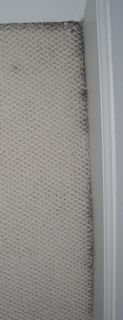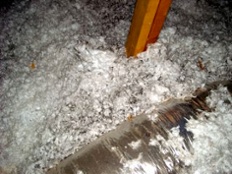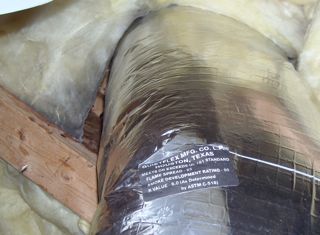The Telltale Sign of Infiltration

Do you have light colored carpet in your home that has dark edges where it meets the baseboard? If so, don’t beat yourself up so much for not being a good enough house cleaner. The problem is probably in your building envelope, not your vacuum cleaner.
Do you have light colored carpet in your home that has dark edges where it meets the baseboard? If so, don’t beat yourself up so much for not being a good enough house cleaner. The problem is probably in your building envelope, not your vacuum cleaner.
The reason the dirt is accumulating there in the first place, you see, is that a lot of air is moving through the carpet at that point. For air to move from one place to another, two conditions must be met:
- A pressure difference drives air from the high pressure side to the low pressure side.
- A pathway allows the air to move.
Pressure differences occur naturally because of wind and the stack effect (warm air rising). They also arise from mechanical systems (bath fans, range hoods, dryers, and duct systems with unbalanced leakage).
Pathways occur because of construction practices that developed before the principles of building science began to be understood and applied. It’s the unsealed top plates in the attic, the open chases, the non-airtight can lights, the uncaulked duct boots, and penetrations galore. When those air leakage sites are connected to wall cavities and air moves across the building envelope under the baseboards, the dirty carpet edges are the result.
Carpet isn’t the only place that dirt exposes air leakage. When you get on the other side of the building envelope, dirty insulation is your clue to air leakage sites. It was really nice of the insulation manufacturers to make their products in colors that show dirt really well – white, yellow, and pink. If they made grey insulation, finding air leaks would be more difficult.
In fact, I found one of my favorite air leaks by spotting some nearly black fiberglass in an attic. It turned out that the filthy insulation was hiding a big hole that a contractor intended to vent the refrigerator to the attic!
 Here are a couple more examples. First, at left you see blown fiberglass insulation in an attic. When new, that insulation was perfectly white. As you can see, there’s plenty of dirt in there now because of the numerous air leaks at the ceiling.
Here are a couple more examples. First, at left you see blown fiberglass insulation in an attic. When new, that insulation was perfectly white. As you can see, there’s plenty of dirt in there now because of the numerous air leaks at the ceiling.
Below, you see a dirty spot in a fiberglass batt near where a duct goes up from the basement through the floor. All you have to do is pull that batt back a little bit, and you’ll see the hole.
So, those dark spots in the  carpet or insulation are a clue, not a problem. Use dirt to your advantage, and find the source of the problem in the air leakage in your house. Seal the leaks, and you’ll have not only a more energy efficient home but a cleaner house, too.
carpet or insulation are a clue, not a problem. Use dirt to your advantage, and find the source of the problem in the air leakage in your house. Seal the leaks, and you’ll have not only a more energy efficient home but a cleaner house, too.
This Post Has 5 Comments
Comments are closed.

I also like looking for the
I also like looking for the spider webs as a sign of air leakage. Usually you will see them flutter and flap when the blower door is running due to a hole (air leak) being near by. People always ask why this is so, but I really don’t have a good answer why. Anyone know why? Do the bugs use these drafts for entering and exiting the building?
Another great post, Alison.
Another great post, Alison.
Jamie, from what I gather, it’s just because that’s where the food tends to be. Flies float around on the drafts, get stuck to the cobwebs, and Charlotte is in business. As to whether the typical air leak is large enough for bugs to actually enter/exit, not sure.
I so wish I knew about this
I so wish I knew about this issue a couple of years ago (or more). I had very light carpets and that black stuff drove me nuts (thank God for Spot Shot). I never thought about a cause, I really did blame myself and my vacuum! Thanks to my brother, I’m learning a lot about sealing my house. I hope to avoid that problem in my current house! Thanks for explaining this. And don’t be surprised if I link my blog back to yours frequently. Please keep educating not only the pros but also us average homeowners!
Jamie, I don’t know how I
Jamie, I don’t know how I missed replying to your comment, but I’m finally doing it. Yes, spider webs are a great tool for the energy auditor because you can see them moving during a Blower Door test.
What I’ve always heard about why they spin their webs in can lights and other air leakage sites is that little bugs move with the breeze, so spiders build in places where air will move across the web. Just like Will said. (Hmmmm. Maybe Will’s answering your question is why I didn’t respond?)
Kermode, thanks for
Kermode, thanks for commenting, and thanks for linking to our blog. I checked out your blog, and it looks like it’s gonna have a lot of good info. (It’s new, right?) Interesting that we both posted on the ‘poor man’s infrared camera’ today!
And thanks for your thanks. In other words, you’re welcome.